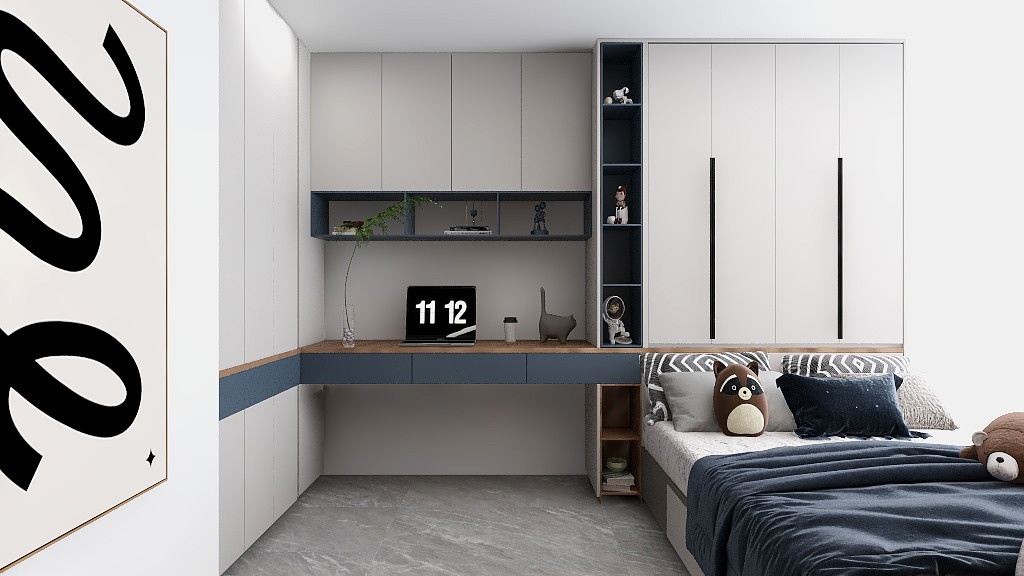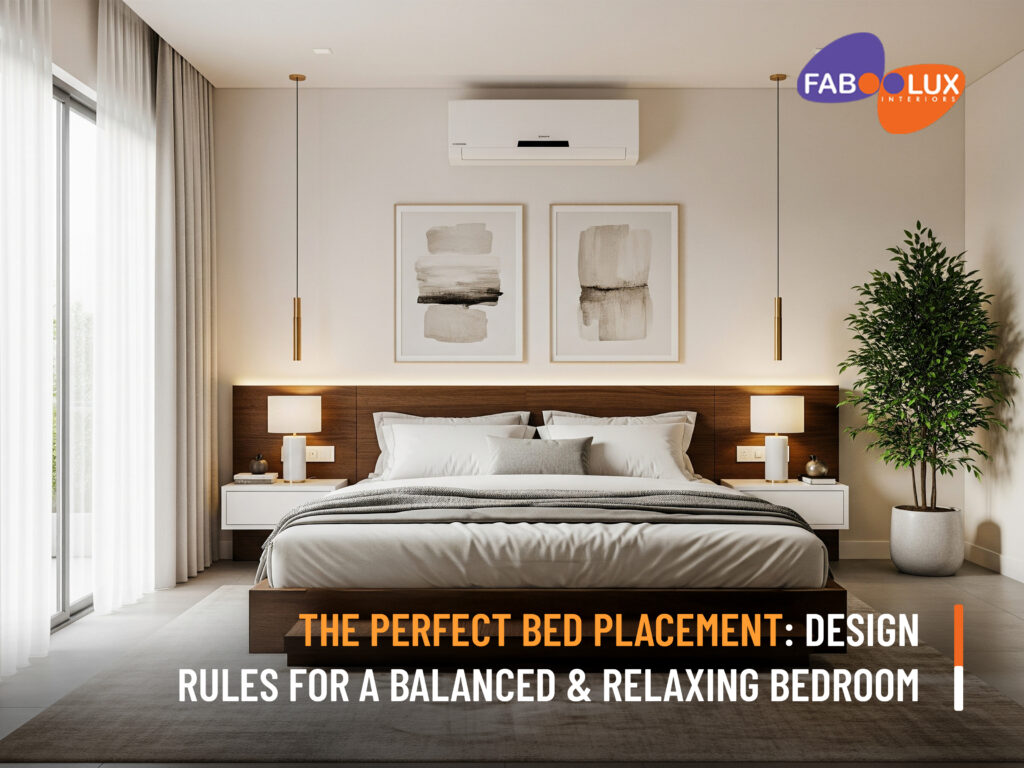When designing a bedroom, the position of the bed might seem like a simple choice—but it plays a crucial role in how the space feels and functions. The right bed placement can improve room balance, circulation, comfort, and even how restful your sleep is. On the other hand, poor positioning can make the space feel cramped, unbalanced, or uncomfortable.
In this blog, we’ll guide you through the essential principles of bed placement, helping you create a bedroom that’s as practical as it is beautiful. Whether you’re working with a compact apartment or a spacious master suite, these expert-backed tips from Faboolux will help you get it right.
Factors to Consider Before Positioning a Bed
Before you decide where to place your bed, consider these practical factors:
- Room Shape and Size: Square rooms often work well with central placement, while rectangular rooms may need more thoughtful positioning.
- Doors and Windows: Ensure the bed doesn’t block entry points or disrupt natural light.
- Purpose of the Room: A master bedroom requires different placement strategies than a guest room or children’s bedroom.
- Light and Ventilation: Where does sunlight enter? Will placing the bed near a window affect comfort?
Every room has unique challenges—and thoughtful planning ensures that your bedroom layout works for both form and function.
Ideal Bed Placement Principles
- Anchor the Bed with a Solid Wall
Placing the head of the bed against a solid wall provides stability, security, and visual grounding. Avoid floating the bed in the center of the room unless done for a specific design purpose. - Allow Balanced Space on Both Sides
Providing equal space (around 24–30 inches) on both sides of the bed enhances symmetry and makes getting in and out easier. - Avoid Direct Alignment with the Door
Beds placed directly in line with the door can disrupt the sense of privacy and comfort. Angled or offset placements work better for flow. - Keep the Bed Away from Windows
Drafts, outdoor noise, and harsh light can interfere with sleep. If your bed must be near a window, opt for blackout curtains and a solid headboard for protection.

Bed Placement in Different Room Sizes
Every bedroom is different, and what works for one space may feel awkward or impractical in another. Whether you’re designing a compact apartment bedroom or a spacious master suite, the size and shape of the room should always influence where the bed goes. Thoughtful bed placement ensures that the room feels balanced, that circulation is smooth, and that both functionality and style are fully optimized. By understanding how to work with different room layouts, you can make even the smallest space feel inviting—or give a large room purpose and definition.
- Small Bedrooms
Maximize floor space by pushing the bed against a single solid wall, using under-bed storage or opting for multifunctional furniture. - Large or Master Bedrooms
Center the bed for balance, and use rugs or light fixtures to define zones, such as seating areas or reading nooks. - Irregular or L-Shaped Rooms
Custom layouts and fitted furniture work best for unusual spaces, helping you use every inch effectively.
Functional Considerations
While aesthetics matter, your bedroom should ultimately work for your everyday life. Functional bed placement ensures that your space not only looks good but also feels comfortable and convenient to use.
- Access is key—there should be enough space to easily get in and out of bed from both sides, especially for double or queen-sized beds. Nightstands should be within easy reach, with enough surface area for essentials like lamps, phones, or books. Power sockets, light switches, and charging points should ideally be positioned close to where you’ll need them.
- Think about circulation: Is there enough room to open wardrobe doors or drawers without bumping into the bed? Does the layout allow for smooth movement between the bed, wardrobe, and bathroom?
- Visual comfort matters too. Whenever possible, place the bed so that when you sit or lie down, you’re facing something pleasing—like a window, artwork, or a feature wall—not just a blank wall or cluttered shelf.
Aesthetic Harmony
While functionality is key, true bedroom design success comes when practicality meets beauty. Aesthetic harmony ensures that your bed placement complements the rest of your interior—creating a balanced, calming, and visually pleasing space.
At Faboolux, we carefully align bed placement with the overall design language of the room. This includes:
- Symmetry: Placing identical nightstands and lamps on either side of the bed creates visual balance. If symmetry isn’t possible, we suggest complementing elements like varying textures, wall art, or lighting to maintain a cohesive look.
- Anchoring Elements: The bed often serves as the focal point of the room. We enhance this with statement headboards, feature walls (like textured panels or wallpaper), or large framed art directly above the headboard.
- Consistency in Materials and Colors: Fabrics, finishes, and colors around the bed should echo those used throughout the space, from cushions and rugs to wardrobe finishes.
- Visual Alignment: The bed should align neatly with ceiling lights, pendant fixtures, or ceiling fans. Misalignment creates subtle discomfort and visual disharmony.
- Proportion Matters: In smaller rooms, oversized beds overwhelm the space. Similarly, in larger rooms, a small bed can feel lost. We select bed sizes that match the room’s scale.
Cultural & Wellness Perspectives
For those who follow traditional design philosophies like Vastu Shastra or Feng Shui, bed placement can also influence well-being. Common recommendations include:
- Positioning the head of the bed toward the south or east for restful sleep.
- Avoiding mirrors that reflect the bed.
- Keeping the bed away from sharp corners or direct door alignments.
While these are optional, many homeowners find comfort in aligning design with cultural or wellness beliefs.
Common Bed Placement Mistakes to Avoid
Even beautifully furnished bedrooms can fail to feel right if the bed placement is poorly planned. Here are some of the most common mistakes homeowners make, and why we help you avoid them:
- Blocking Natural Light or Airflow: Beds placed in front of windows or ventilation points disrupt both light and comfort, making the room feel stuffy or dim.
- Pushing the Bed into Corners (Without Intent): While necessary in some smaller rooms, pushing a bed into a corner often creates awkward access, especially for double or queen beds. Ideally, there should be balanced space on both sides for ease of movement and symmetry.
- Ignoring Furniture Alignment: Misalignments between the bed and other furniture (wardrobes, shelves, ceiling lights) create visual discomfort. Poor alignment can also affect practical access to storage.
- Poor Access to Essentials: Beds placed too far from switches, power outlets, or wardrobes add daily inconvenience. We always plan for reachable controls and accessible furniture.
- Overcrowding with Furniture: Adding large wardrobes, desks, or dressers around an awkwardly placed bed can shrink usable space and make the room feel cluttered.
- Disregarding Views: If possible, we ensure that your bed faces or has sightlines to something pleasant—like a window, artwork, or focal wall. Avoid placing beds where the primary view is of a blank wall or obstructive furniture.

Professional Tips from Faboolux
At Faboolux, bed placement is never an afterthought—it’s part of a carefully planned process that considers architecture, aesthetics, and your personal preferences.
Here’s how we elevate bedroom design beyond the ordinary:
- Customized Layout Planning: We never follow a one-size-fits-all approach. Each layout is developed based on the specific proportions and orientation of your space.
- 3D Visualization Before Execution: With our FabDesign Tool, you’ll see exactly how your bed—and the entire bedroom—will look before finalizing the plan. This removes guesswork and allows for adjustments before installation.
- Personalized Recommendations: Do you want a reading nook, workspace, or extra storage? We incorporate multi-functional elements around your bed to ensure the room works for your lifestyle.
- Climate and Comfort Considerations: In Kerala’s climate, cross-ventilation is vital. We optimize bed placement to allow airflow, minimize glare, and position cooling solutions (like fans or AC units) where they’ll be most effective.
- Integrated Aesthetic Planning: Your bed isn’t just furniture—it’s the centerpiece of the room. We coordinate everything from bed linens to bedside lighting and storage so that form meets function seamlessly.
- In-House Execution, Zero Coordination Hassles: Since Faboolux manages everything—from design to production in our own factory to final installation—you enjoy a hassle-free experience, consistent quality, and precise execution.
Conclusion
Perfect bed placement is more than just deciding where the headboard should go—it’s about creating a sense of comfort, balance, and flow that makes your bedroom feel like a personal retreat. With thoughtful planning, you can transform even the most challenging spaces into well-organized, restful environments.
At Faboolux, we don’t just design bedrooms—we shape spaces that fit your lifestyle, your taste, and your daily routines. From expert planning to advanced visualization with the FabDesign Tool named FabSketch, and execution by experienced professionals, we help you make confident choices at every step. Your dream bedroom isn’t far away—start designing it with Faboolux today.

